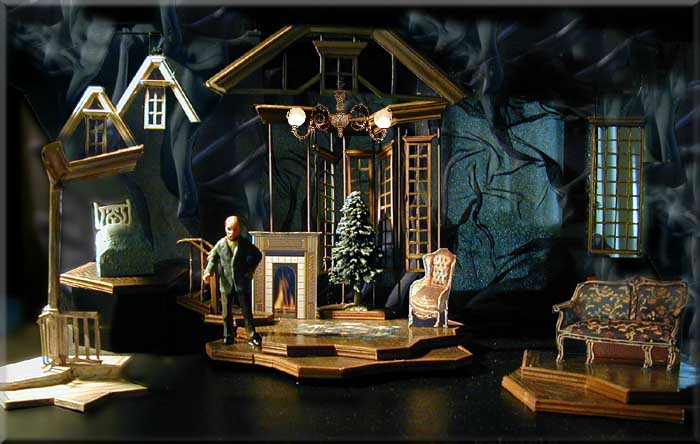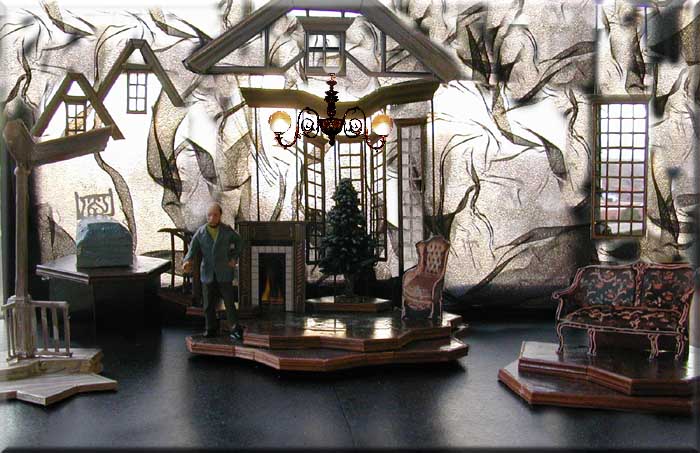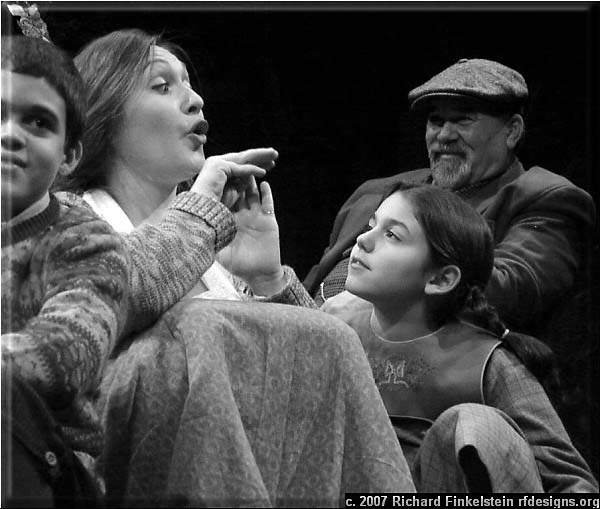A Child's Christmas in Wales
- Winter 2000 production for The National Theatre
of the Deaf. The Set Design is by Richard Finkelstein. Depicted below are two views of the model. This adaptation of the work of Dylan
Thomas, is by Burgess Clark, with direction by Peter Flynn




Description of the Setting:
The setting as originally designed consisted of
four disjointed islands floating within a black void. The central island
depicted the living room with skeletal elements including a Christmas
tree (brought in mid-action), fireplace, and a hint of windows and
architectural elements. Overhead to help frame in the area was a
skeletal depiction of a Welsh roof-line.
Up-right of this and at a higher level was a
smaller island serving as the young Dylan�s bedroom. This too was
framed in overhead by a depiction of dormer windows.
The Down left island served as home to various
relatives. The area was decorated with a small sofa and framed in with a
skeletal window. Down right was an island with a hint of the haunted
house featured in the action of the play.
The islands themselves were shaped in a manner
reminiscent of ice crystals. The three main islands had a surface
treatment of polished floorboards while the haunted island was rendered
in a distressed wood manner. The stage floor proper was painted gloss
black so as to be in stark contrast to the islands and so as to
disappear.
A number of the venues we were to tour to had
no cyc and often had no good way to rig one so the set had to provide
for a non drop-based backing. I chose to utilize a crushed window screen
cyc similar to those developed earlier by Josef Svoboda. I like the
eternal and light-reactive quality of the media. The texture of the
crushed screen helps to reinforce the textures of winter as well.
In the original scheme the central island was
to rotate along with the steps which were designed to lead between this
area and young Dylan�s bedroom. The show was to begin with Dylan
literally isolated in his bedroom, un-connected to the rest of the
world, while the center island depicted the exterior of the house. Alas
this wonderful idea was the first victim of the budget realities. In the
end we had to live with a static set. The other major element cut in the
end were the windows and cornice of the the central island set.
The blackness of the stage surrounding the
islands allowed for the last element to work properly: snow. A lot of
snow was used in this production and it had a transformational function
as the black floor slowly turned white as the action progressed, also
serving to link the separate islands into a cohesive unity.
Conceptual Foundations:
Dramaturgical considerations were an important
part of the process of developing this piece from the start. It is a
mode of designing that I enjoy most as it is when I get to work with a
playwright directly. Burgess Clark takes the raw poem by Dylan Thomas
and adds within the structure a whole layer of context. Burgess uses the
work as a vehicle to explore the genesis of creativity. The original
poem is a monologue. It has wonderful language but little of plot line
on which to develop a strong theatrical script for multiple actors.
What Dylan Thomas� work does though is to
paint an incredible snapshot of images and emotions and ambiance of this
Welsh town in 1923 and its inhabitants.
In our adaptation though, Burgess Clark uses
these memories depicted in Thomas� original poem as an indication of
how an artist can be inspired as a young boy to BECOME an artist. In
this world, Thomas is recounting in a way how he first began to remember
the joy of life that would later illustrate the characters in his
writing.
So, in this version, each of the disjointed
memories is actually the building block in the making of a future
artist. To this end too, there are many small elements of repetition and
symmetry in the dialogue. Certain lines have meaning when first uttered
only to take on further layers of meaning with later iterations,
especially with the development and maturation of Dylan.
In the end though the scenes are always scenes
of reality....as remembered and recorded by a young Dylan....and
re-interpreted through the eyes of the mature Dylan, Dylan the poet.
In the setting, the idea of the islands became
important to these dramaturgical ends. They allowed for the physical
manifestation of how snippets of memory float within our minds. The
physical juxtaposition of the setting also allows for a movement
parallel as Dylan moves from childhood to maturity, able to "put
the pieces together" as it were. In our original kinetic conception
this was even more apparent as Dylan at the start was totally physically
isolated with bridges supplied only with the love of family and the
opening of the eyes of a poet.
The islands were not the only areas for action.
The black areas of the floor between the islands became important too.
Besides transitional spaces for movement between the islands, these
depicted the cold outside, never far from the warmth of family and fire
within. Dylan Thomas� depictions of the beauty and rejuvenating power
of the snow are also so very powerful and beautiful, the black areas
around the platforms allowed us to make the most effective visual
statement as the snow literally transformed the stark world into one of
peace and stillness and beauty by the end of the play.
|




